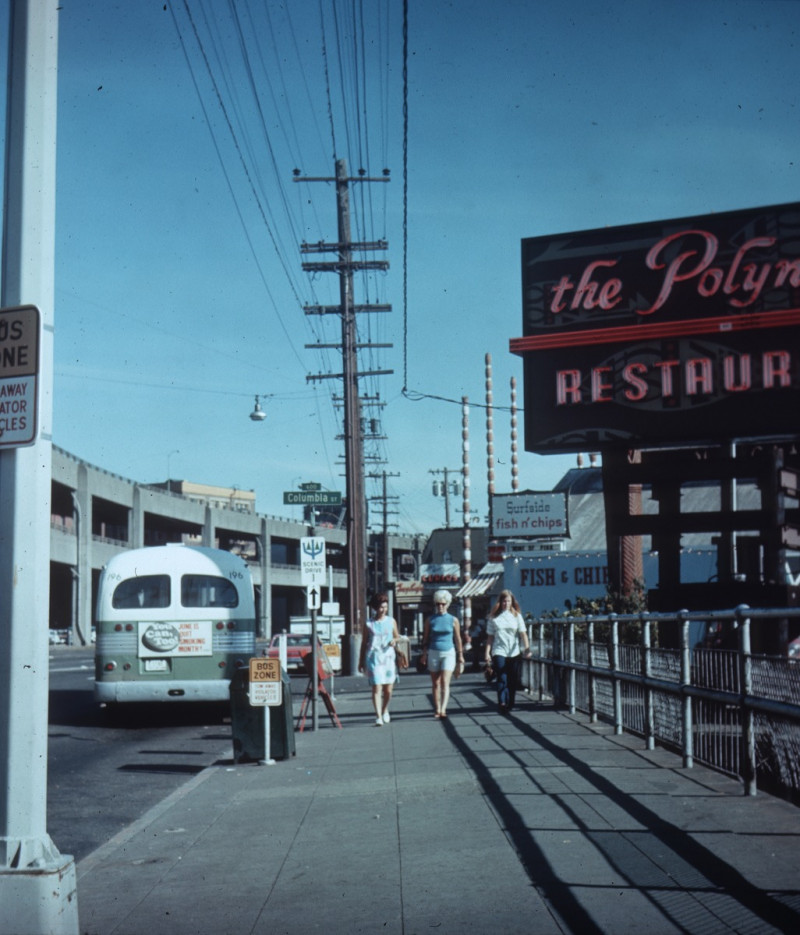When do you think this photo was taken?
About This Photo:
In the 1970s, Alaskan Way in Seattle was a bustling waterfront area, teeming with ships, passengers, and the energy of a city on the rise. A particularly notable spot along this stretch was Pier 51, home to the iconic Polynesian restaurant, a beloved Seattle institution that would become a part of the city’s cultural fabric during its time. The scene at Alaskan Way near Pier 51 circa 1970 provides a fascinating look back at a different era in Seattle's history, capturing both the vibrancy of the city’s waterfront and the transformation that would come in the decades that followed.
The Polynesian Restaurant on Pier 51
The Polynesian restaurant, located on Pier 51, was a standout feature of Seattle’s waterfront in the 1960s and 1970s. The restaurant’s exotic décor, inspired by the South Pacific, was a striking contrast to the industrial landscape of the area. Offering a tropical escape with tiki-inspired cocktails, dimly lit bamboo lounges, and a menu full of exotic dishes, The Polynesian quickly became a favorite gathering spot for both locals and visitors. The building itself was an architectural gem, complete with thatched roofs and Polynesian-style carvings, evoking an image of escapism in the heart of Seattle's maritime district.
The restaurant’s proximity to Pier 51 also made it a convenient spot for sailors, tourists, and workers passing through the area. It became a symbol of the leisure and entertainment options that dotted Seattle’s waterfront, providing a cultural oasis amidst the port’s commercial activities.
Alaskan Way and Pier 51’s Evolution
At the time, the waterfront along Alaskan Way was a key artery for Seattle’s economy, supporting the bustling maritime industry and the port’s ongoing operations. The surrounding piers were filled with warehouses, shipyards, and docks, creating a busy but often gritty environment. Pier 51, specifically, had a dual role: while it served as an active port, it also accommodated the leisure activities provided by establishments like The Polynesian, offering an intriguing mix of industrial and recreational use.
However, as Seattle evolved and the city’s waterfront began to modernize, significant changes came to the area. The Polynesian restaurant, once a beloved landmark, closed its doors in the early 1970s. The building was eventually demolished, and Pier 51, once a hub for dining and entertainment, became part of the expansion for the Washington State Ferries terminal. The transformation of the area marked the end of an era for both Pier 51 and Alaskan Way’s waterfront landscape.
The Legacy of the Polynesian and Alaskan Way
Today, the location that once housed The Polynesian restaurant is part of the Washington State Ferries terminal, a vital piece of Seattle’s transportation infrastructure. While the tiki restaurant is long gone, the history of Alaskan Way and Pier 51 during the 1970s remains an important part of Seattle's cultural memory. The area that was once filled with the sounds of sailors and tourists now serves as a gateway for ferry passengers heading to destinations like Bainbridge Island, Edmonds, and the San Juan Islands.
The evolution of Alaskan Way from a mixed-use waterfront to its current state serves as a testament to the growth of Seattle and its ongoing transformation into a modern, bustling urban center. Despite the changes, the memory of places like The Polynesian restaurant continues to live on in the hearts of those who remember the vibrant energy of the past. The history of Alaskan Way, near Pier 51, is a reminder of Seattle’s dynamic history and the continuous interplay between the city’s industrial roots and its cultural evolution.

